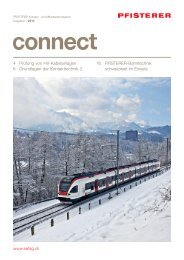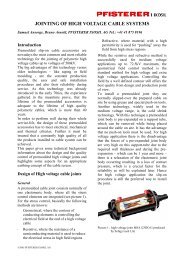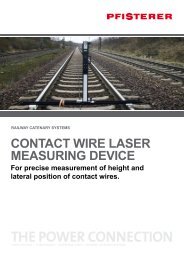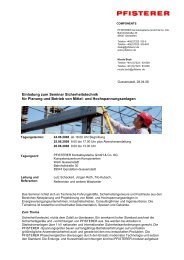Bending of helically twisted cables under variable ... - Pfisterer
Bending of helically twisted cables under variable ... - Pfisterer
Bending of helically twisted cables under variable ... - Pfisterer
Create successful ePaper yourself
Turn your PDF publications into a flip-book with our unique Google optimized e-Paper software.
Where µ L is is the the coefficient coefficient <strong>of</strong> <strong>of</strong> friction friction between between the the wire element element <strong>under</strong> <strong>under</strong> consideration consideration and and its subsurface,<br />
e.g. the core wire <strong>of</strong> the cable.<br />
Maintaining intaining the the static static balance balance <strong>of</strong> <strong>of</strong> forces forces in in the the axial axial direction <strong>of</strong> <strong>of</strong> the wire we obtain, Fig. 2.5:<br />
Where dZL is is the the maximum maximum difference difference in in tensile tensile force a wire wire element element can resist resist through through friction.<br />
friction.<br />
Fig. 2.5 Force relationships in a wwire<br />
element in layer L<br />
Integrating (2.14) over φ and inserting the boundary condition<br />
yields<br />
Where Zd,L is is the the tensional tensional stress stress on on the the wire wire alone, alone, in acc. with (2.5), which is the same same for all wires wires in<br />
layer L.<br />
ZL, however, is the maximum (total) tension ZZL(φ)<br />
) that can be countered by friction force at every point φ<br />
on the wire. Apart from tension force Zd,L Z countering only tension stress therefore, friction generates a<br />
<strong>variable</strong> tension force component along the wires <strong>of</strong> layer L, provided the relative movement is<br />
sufficient:<br />
13

















